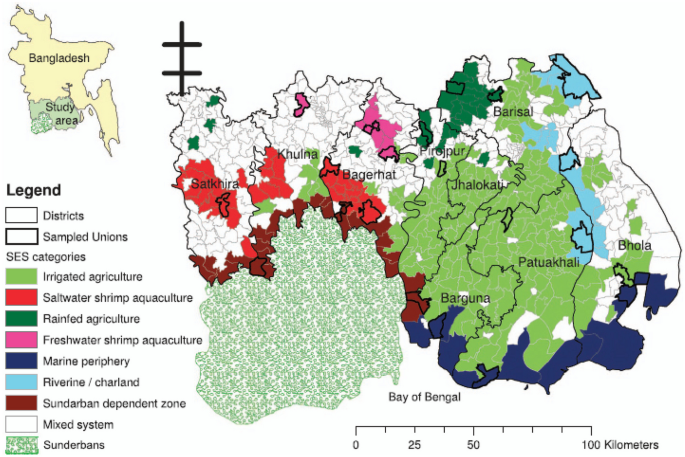当地环境对儿童营养状况的影响:季节性因素与孟加拉国西南沿海地区5岁以下儿童消瘦之间的关系如何?
IF 2.5
3区 社会学
Q1 DEMOGRAPHY
引用次数: 0
摘要
短期环境变化对儿童营养状况的影响在人群中不是恒定的。在许多国家,季节与许多已知影响营养结果的因素密切相关,如粮食消费、作物收成、就业机会和疾病。随着极端季节变化变得越来越普遍,了解季节性与儿童营养状况的关系至关重要。本研究将在一年的时间内探索孟加拉国西南部沿海河流三角洲急性营养不良的时空变化和决定因素。利用2014 - 2015年进行的农村纵向调查,共进行了3次调查,研究了5岁以下儿童的消瘦情况。通过“社会生态系统”分析了空间变化,该系统捕捉了生态系统、生计和人口之间的相互作用。消瘦率从季风季节的18.2%到主要水稻收获后的8.7%不等(阿曼)。在社会生态系统中,季节与持续的浪费没有关系,一些系统随着时间的推移表现出更大的变化,突出了营养状况的明显季节性动态。正如预期的那样,较富裕的社会生态系统的浪费一般较低,有更多的生计多样化机会和平稳消费的战略。营养干预措施在实施方案时必须考虑急性营养不良的季节性高峰以及环境背景,以最大限度地提高效果。随着季节变化的变异性越来越大,在健康促进活动中必须考虑到季节影响的不平等。此外,调查实施的时间和季节是营养研究中需要考虑的重要因素,特别是在比较两个横断面调查时。本文章由计算机程序翻译,如有差异,请以英文原文为准。

The effect of the local environment on child nutritional outcomes: how does seasonality relate to wasting amongst children under 5 in south-west coastal Bangladesh?
Abstract The impact of short-term environmental changes on child nutritional status is not constant within populations. In many countries, the seasons are closely linked with many factors that are known to affect nutritional outcomes, such as food consumption, crop harvests, employment opportunities and illness. With extreme seasonal variation becoming more common, understanding how seasonality is related to child nutritional outcomes is vital. This study will explore spatial and temporal variation and determinants for acute malnutrition in a coastal river delta in south-west Bangladesh over the period of a year. Using a rural longitudinal survey, conducted in 2014–15 with 3 survey waves, wasting amongst children under 5 was studied. Spatial variation was analysed through ‘socio-ecological systems’, which capture interactions between ecosystems, livelihoods and populations. Wasting prevalence varied from 18.2% in the monsoon season to 8.7% post-major rice harvest (Aman). Seasons did not relate to wasting consistently over socio-ecological systems, with some systems showing greater variability over time, highlighting distinct seasonal dynamics in nutritional status. Wealthier socio-ecological systems had lower wasting generally, as expected, with greater livelihood diversification opportunities and strategies to smooth consumption. Nutrition interventions must consider seasonal peaks in acute malnutrition, as well as the environmental context when implementing programmes to maximise effectiveness. With increasing variability in seasonal changes, inequalities in the impact of season must be accounted for in health promotion activities. Furthermore, timing and season of survey implementation is an important factor to be accounted for in nutrition research, especially when comparing between two cross-sectional surveys.
求助全文
通过发布文献求助,成功后即可免费获取论文全文。
去求助
来源期刊

Population and Environment
Multiple-
CiteScore
5.80
自引率
6.10%
发文量
18
期刊介绍:
Population & Environment is the sole social science journal focused on interdisciplinary research on social demographic aspects of environmental issues. The journal publishes cutting-edge research that contributes new insights on the complex, reciprocal links between human populations and the natural environment in all regions and countries of the world. Quantitative, qualitative or mixed methods contributions are welcome.
Disciplines commonly represented in the journal include demography, geography, sociology, human ecology, environmental economics, public health, anthropology and environmental studies. The journal publishes original research, research brief, and review articles.
 求助内容:
求助内容: 应助结果提醒方式:
应助结果提醒方式:


